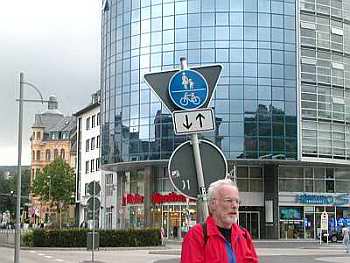

Koblenz

The
Mosel flows northeast into the Rhine at Koblenz. At the point
where the Mosel meets the Rhine, an angle is formed and the
resulting triangular piece of land became known as the Deutsches Eck, or
the "German Corner". At the tip of this land is a plaza where
stands the memorial to Emperor Wilhelm I, built by his son
Wilhelm II. Originally, Deutsches Eck referred to the fortress
built by the German Order in the medieval ages.

In
1908, Emperor Wilhelm II was vacationing at Sognefjord when he
heard about the big fire in Ålesund in the northern part of west-Norway.
He headed north to Ålesund in his yacht to help in the rescue
work, digging into his private coffers to give financial help to
the fire victims. One of the beneficiaries was Rolf's great
grandmother. Going to the Deutsches was the main reason for
stopping by Koblenz on our way to the Lorelei valley. Rolf wanted
to pay his respects to the two Wilhelms.

Koblenz is a very old city, at least 2000 years
old, counting from the time that it was a Roman camp. On the
fortress wall facing the Mosel river was etched the German Cross,
the symbol of Germany that has survived up to the present time.
About 80% of Koblenz lay in ruins after World War II but the wall
with the German Cross somehow survived the bombing.
Downtown
Koblenz is an interesting mix of the old and the new. A 19th
century style building on the same block as a modern building is
an ordinary sight.


 The Hauptbahnhof in Koblenz is small but
is as modern as any central station in Germany, although it may
not be immediately apparent looking at its architectural style.
On the low hill beside the Hauptbahnhof is an old fortress.
The Hauptbahnhof in Koblenz is small but
is as modern as any central station in Germany, although it may
not be immediately apparent looking at its architectural style.
On the low hill beside the Hauptbahnhof is an old fortress.
It was not until we
were back home that the impact of the "Deutsches Eck" on me became
clear. What I had seen in Koblenz and, later, in Aachen was a
historical continuum. The fortress wall with the German Cross has stood
at the Deutsches Eck for 1200 years and I have almost given up on my
native country which is less than 500 years old! Compared to Germany and
the rest of Europe, my native country is just an infant.
That gives me a ray
of hope,
dim, but still a sense of hope.

Go to
Next
Page |


![]()





 The Hauptbahnhof in Koblenz is small but
is as modern as any central station in Germany, although it may
not be immediately apparent looking at its architectural style.
On the low hill beside the Hauptbahnhof is an old fortress.
The Hauptbahnhof in Koblenz is small but
is as modern as any central station in Germany, although it may
not be immediately apparent looking at its architectural style.
On the low hill beside the Hauptbahnhof is an old fortress. ![]()